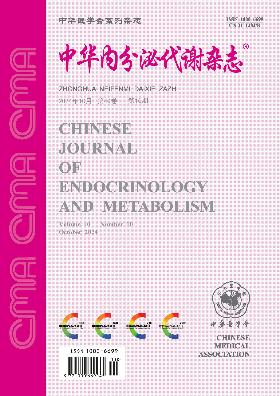Relationship between sex hormones, lipids and visceral fat area in postmenopausal women with type 2 diabetes mellitus
Q4 Medicine
引用次数: 0
Abstract
Objective To study the characteristics and correlation of sex hormone levels, blood lipids, and visceral fat area in postmenopausal women with T2DM. Methods A total of 258 cases of postmenopausal T2DM were recruited, including 46 cases of menopause for 1-5 years (group A), 49 cases of menopause for 6-10 years (group B), and 163 cases with menopause more than 10 years (C group). The related clinical information of patients was recorded. Results Compared among the three groups, there were statistical differences in total cholesterol(F=3.287, P=0.039) and testosterone(Chi-Square=8.324, P=0.016). No significant difference in FSH, LH, estradiol, low density lipoprotein, triglyceride, visceral fat area and subcutaneous fat area(P>0.05) among three groups was observed. After correction of confounding factors, FSH was independently positively related with for total cholesterol and low-density lipoprotein respectively (P=0.006, P=0.009). LH was independently positively related with total cholesterol(P=0.003) and low-density lipoprotein respectively(P=0.003). Estradiol was independently negatively related with total cholesterol(P=0.014) and low-density lipoprotein(P=0.020), respectively. Testosterone was correlated independently with visceral fat area(P=0.008); FSH, LH, estradiol, and testosterone were not correlated to triglyceride and subcutaneous fat area(P>0.05). Conclusion (1)In T2DM patients with the increase of postmenopausal time, the total cholesterol increases first, and then decreases; testosterone decreases first, and then increases. (2)In T2DM patients, the total cholesterol and low-density lipoprotein increase with the increase of FSH and LH, increase with the decrease of estradiol, and the area of visceral fat increases with the testosterone together. Key words: Diabetes mellitus, type 2; Postmenopausal women; Sex hormones; Blood lipids; Visceral fat area绝经后2型糖尿病妇女性激素、脂质和内脏脂肪面积的关系
目的探讨绝经后2型糖尿病患者性激素水平、血脂和内脏脂肪面积的特点及其相关性。方法收集258例绝经后2型糖尿病患者,其中绝经1-5年46例(A组),绝经6-10年49例(B组),更年期10年以上163例(C组)。记录患者的相关临床信息。结果三组间比较,总胆固醇(F=3.287,P=0.039)和睾酮(卡方=8.324,P=0.016)均有统计学差异,FSH、LH、雌二醇、低密度脂蛋白、甘油三酯、内脏脂肪面积和皮下脂肪面积差异无统计学意义(P>0.05)。在校正混杂因素之后,FSH与总胆固醇和低密度脂蛋白分别独立呈正相关(P=0.006,P=0.009),LH与总胆固醇(P=0.003)和低密度脂肪蛋白分别独立正相关(P=0.003。睾酮与内脏脂肪面积独立相关(P=0.008);FSH、LH、雌二醇和睾酮与甘油三酯和皮下脂肪面积无相关性(P>0.05)。结论(1)T2DM患者随着绝经后时间的增加,总胆固醇先升高后降低;睾酮先下降,然后上升。(2) T2DM患者的总胆固醇和低密度脂蛋白随FSH和LH的增加而增加,随雌二醇的减少而增加,内脏脂肪面积随睾酮的增加而增大。关键词:糖尿病,2型;绝经后妇女;性激素;血脂;内脏脂肪区
本文章由计算机程序翻译,如有差异,请以英文原文为准。
求助全文
约1分钟内获得全文
求助全文
来源期刊

中华内分泌代谢杂志
Medicine-Endocrinology, Diabetes and Metabolism
CiteScore
0.60
自引率
0.00%
发文量
7243
期刊介绍:
The Chinese Journal of Endocrinology and Metabolism was founded in July 1985. It is a senior academic journal in the field of endocrinology and metabolism sponsored by the Chinese Medical Association. The journal aims to be the "Chinese broadcaster of new knowledge on endocrinology and metabolism worldwide". It reports leading scientific research results and clinical diagnosis and treatment experience in endocrinology and metabolism and related fields, as well as basic theoretical research that has a guiding role in endocrinology and metabolism clinics and is closely integrated with clinics. The journal is a core journal of Chinese science and technology (a statistical source journal of Chinese science and technology papers), and is included in Chinese and foreign statistical source journal databases such as the Chinese Science and Technology Papers and Citation Database, Chemical Abstracts, and Scopus.
 求助内容:
求助内容: 应助结果提醒方式:
应助结果提醒方式:


